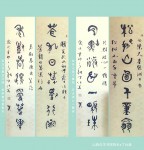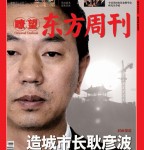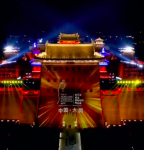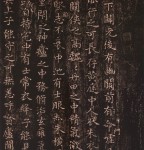Cursive script emerged in the early years of the Han dynasty as a result of its convenience in writing. Its basic characteristics can be summed up as: an impression of vigorous and unrestrained spirit is revealed in the rhythmic and fast movement of brushes.
There are three phases of the development of cursive script - early cursive script, Zhang style cursive script, and modern cursive script. Early cursive script paralleled in development with official script and was generally called "official cursive script", which had some elements of seal-cursive script. Zhang style cursive script was a blend of early cursive with Han official script, with strokes hooked together in forms of waves, each character standing independently from another, flat and square and moving horizontally.
In the last Han Dynasty, Zhang style cursive script developed even further, leaving off traces of official script. The strokes of characters were interconnected, and the components and radicals of characters came to be simplified and mutually borrowable. And thus came into being modern cursive script, which has been prospering since the Wei and Jin Dynasties.
In Tang dynasty, the writing of modern cursive script came to be more vigorous and unrestrained. With strokes interlinked and encircling and character shapes grotesquely changing, it got its name "wild cursive script" or "highly cursive hand". Cursive writing, however, is not equated with random at-will scribbling. Instead, certain rules should be followed, for example, the links of dots and strokes, the simplification of character structure and the borrowing of components.
In the history of Chinese calligraphy, many master calligraphers got famous for their cursive scripts, such as Zhang Xu, Huai Su, and Zhi Yong in ancient time, who are acclaimed the "saints of cursive script", and in modern time, Mao Zedong, the founder of the People's Republic of China, and Yu Youren, the senior statesman of Chinese Nationalist Party (KMT).
| < Prev | Next > |
|---|
- 2011-03-15 - Basics Knowledge of Chinese Characters & Symbols
- 2011-01-09 - 从史籍无闻到“天下第一行书”——浅析唐太宗对《兰亭序》的“接受过程”
- 2010-12-30 - History of Chinese calligraphy : South North and Sui dynasty
- 2010-12-24 - Oracle Bones of Ancient ChinaOracle Bone Script
- 2010-12-23 - 论用笔与结字:书法艺术成熟的三大历史阶段
- 2010-12-20 - The Calligraphic Spirit
- 2010-08-27 - Introduction to Chinese Calligraphy
- 2010-01-18 - Modern Poetry in China : A Shimmering Window
- 2010-01-10 - 关于“请循其本”:古代书法创作研究国际学术讨论会的几点感想
- 2009-12-02 - 浅析书法演进理路














